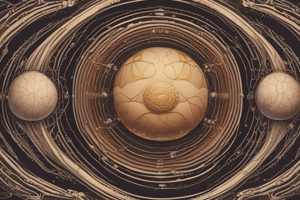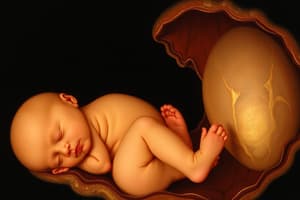Podcast
Questions and Answers
During which stage of prenatal development is the developing baby most susceptible to teratogens?
During which stage of prenatal development is the developing baby most susceptible to teratogens?
- Germinal Stage
- All stages are equally susceptible
- Fetal Stage
- Embryonic Stage (correct)
What is the significance of the placenta during prenatal development?
What is the significance of the placenta during prenatal development?
- It facilitates the exchange of oxygen and nutrients between the mother and the embryo. (correct)
- It protects the developing baby from teratogens.
- It is responsible for the initial formation of the neural tube.
- It dictates the genetic makeup of the developing baby.
At what point during prenatal development is the developing baby first referred to as a fetus?
At what point during prenatal development is the developing baby first referred to as a fetus?
- At conception
- At the beginning of the germinal stage
- At the beginning of the fetal stage (correct)
- At the beginning of the embryonic stage
What event signifies the beginning of the germinal stage of prenatal development?
What event signifies the beginning of the germinal stage of prenatal development?
The risk of neural tube defects, such as spina bifida, is increased by a deficiency in which nutrient during pregnancy?
The risk of neural tube defects, such as spina bifida, is increased by a deficiency in which nutrient during pregnancy?
How might high levels of stress hormones in a pregnant woman impact prenatal development?
How might high levels of stress hormones in a pregnant woman impact prenatal development?
Advanced maternal age (35+) is associated with an increased risk of what prenatal complication?
Advanced maternal age (35+) is associated with an increased risk of what prenatal complication?
Teen pregnancies are often associated with which of the following risks?
Teen pregnancies are often associated with which of the following risks?
What is a key characteristic of infants physical development between 0-12 months?
What is a key characteristic of infants physical development between 0-12 months?
A child is observed playing next to other children without interacting with them. According to the stages of play, which type of play is depicted here?
A child is observed playing next to other children without interacting with them. According to the stages of play, which type of play is depicted here?
During which period do children typically begin to show self-awareness and express complex emotions such as pride and shame?
During which period do children typically begin to show self-awareness and express complex emotions such as pride and shame?
What does secure attachment in infants lead to, according to John Bowlby's attachment theory?
What does secure attachment in infants lead to, according to John Bowlby's attachment theory?
According to Erik Erikson's stages of psychosocial development, what is the key challenge during infancy (0-1 year)?
According to Erik Erikson's stages of psychosocial development, what is the key challenge during infancy (0-1 year)?
Which scenario is an example of symbolic thought in toddlers, as described within Piaget's sensorimotor stage?
Which scenario is an example of symbolic thought in toddlers, as described within Piaget's sensorimotor stage?
According to the information, what percentage of its adult size has the brain typically reached by age 3?
According to the information, what percentage of its adult size has the brain typically reached by age 3?
The strengthening of neural connections through sensory experiences and interactions is a key aspect of what area of development in infancy and toddlerhood?
The strengthening of neural connections through sensory experiences and interactions is a key aspect of what area of development in infancy and toddlerhood?
Which of the following milestones typically occurs during toddlerhood (1-3 years) with respect to gross motor skills?
Which of the following milestones typically occurs during toddlerhood (1-3 years) with respect to gross motor skills?
What fine motor skill typically emerges during infancy (4-5 months)?
What fine motor skill typically emerges during infancy (4-5 months)?
At what age can a toddler walk independently, kick a ball, and begin climbing stairs?
At what age can a toddler walk independently, kick a ball, and begin climbing stairs?
From the options below, which most correctly describes the term teratogen?
From the options below, which most correctly describes the term teratogen?
What is the correct order that babies develop gross motor skills?
What is the correct order that babies develop gross motor skills?
Which is an example of a two-word sentence?
Which is an example of a two-word sentence?
How should you describe 'myelination'?
How should you describe 'myelination'?
A child who is 15-months-old may struggle using which utensil?
A child who is 15-months-old may struggle using which utensil?
During what stage of cognitive development does trial-and-error learning occur?
During what stage of cognitive development does trial-and-error learning occur?
Flashcards
Pre-Natal Development
Pre-Natal Development
The process by which a human embryo and later a fetus develops inside the mother's womb from conception to birth.
Germinal Stage
Germinal Stage
Begins at conception and lasts for 0-2 weeks; a sperm fertilizes an egg, forming a single-celled zygote.
Embryonic Stage
Embryonic Stage
Lasts from 3-8 weeks, where the developing baby is now called an embryo.
Fetal Stage
Fetal Stage
Signup and view all the flashcards
Teratogens
Teratogens
Signup and view all the flashcards
Alcohol (Prenatal Hazard)
Alcohol (Prenatal Hazard)
Signup and view all the flashcards
Drugs (Prenatal Hazard)
Drugs (Prenatal Hazard)
Signup and view all the flashcards
Infections (Prenatal Hazard)
Infections (Prenatal Hazard)
Signup and view all the flashcards
Folic Acid Deficiency
Folic Acid Deficiency
Signup and view all the flashcards
Maternal Stress
Maternal Stress
Signup and view all the flashcards
Teen Pregnancies
Teen Pregnancies
Signup and view all the flashcards
Advanced Maternal Age
Advanced Maternal Age
Signup and view all the flashcards
Infancy/Toddlerhood
Infancy/Toddlerhood
Signup and view all the flashcards
Physical Development
Physical Development
Signup and view all the flashcards
Newborn Size
Newborn Size
Signup and view all the flashcards
Motor Development
Motor Development
Signup and view all the flashcards
Infant Gross Motor Skills
Infant Gross Motor Skills
Signup and view all the flashcards
Toddler Gross Motor Skills
Toddler Gross Motor Skills
Signup and view all the flashcards
Infant Fine Motor Skills
Infant Fine Motor Skills
Signup and view all the flashcards
Toddler Fine Motor Skills
Toddler Fine Motor Skills
Signup and view all the flashcards
Brain Growth
Brain Growth
Signup and view all the flashcards
Cognitive Development
Cognitive Development
Signup and view all the flashcards
Sensorimotor Stage
Sensorimotor Stage
Signup and view all the flashcards
Infant Language
Infant Language
Signup and view all the flashcards
Social/Emotional Development
Social/Emotional Development
Signup and view all the flashcards
Study Notes
Pre-Natal Development
- This is the process where a human embryo and later a fetus develops in the mother's womb from conception to birth.
- This period is crucial for physical, cognitive, and emotional development.
Stages of Pre-Natal Development
- There are three distinct stages of pre-natal development.
Germinal Stage (0-2 weeks)
- This stage begins at conception when a sperm fertilizes an egg, forming a single-celled zygote.
- The zygote divides rapidly and forms a blastocyst.
- The blastocyst travels through the fallopian tube and implants in the uterine wall.
- The placenta begins to develop, which allows for the exchange of oxygen and nutrients between the mother and the embryo.
Embryonic Stage (3-8 weeks)
- The developing baby is called an embryo during this stage.
- Major organs and structures like the heart, brain, spinal cord, limbs, and facial features start to form.
- The neural tube closes by the fourth week, later developing into the central nervous system (brain and spinal cord).
- The heart starts beating around 6 weeks.
- The embryo is highly sensitive to teratogens (alcohol, drugs, infections) that can cause birth defects.
Fetal Stage (9 weeks to birth)
- The developing baby is called a fetus during this stage.
- Growth is rapid, and the organs continue to mature.
- The fetus starts showing reflexive movements, like kicking, sucking, and swallowing.
- By 24 weeks, the fetus is considered viable and has a chance of survival outside the womb with medical support.
- The third trimester (28 weeks onward) is crucial for brain development and weight gain.
Factors Influencing Pre-Natal Development
- Several factors can impact the health and development of the fetus.
Genetic Factors
- Chromosomal abnormalities such as Down syndrome and Turner syndrome affect development.
- Inherited genetic disorders like cystic fibrosis and sickle cell anemia can impact the fetus.
Teratogens (Environmental Hazards)
- Alcohol can cause Fetal Alcohol Syndrome.
- Drugs (nicotine, cocaine) can result in low birth weight, premature birth, or developmental delays.
- Infections (rubella, Zika virus) can lead to congenital disabilities.
Maternal Health and Nutrition
- Poor nutrition may result in low birth weight and developmental issues.
- Folic acid deficiency increases the risk of neural tube defects like spina bifida.
Stress and Emotional Well-Being
- High levels of stress hormones (cortisol) in the mother can impact fetal brain development.
Age of the Mother
- Teen pregnancies may result in low birth weight and complications.
- Advanced maternal age (35+) increases the risk of chromosomal abnormalities.
Infancy and Toddlerhood: Stages and Developmental Milestones
- Infancy (birth to 12 months) and toddlerhood (1 to 3 years) are critical periods of rapid growth and development.
- Children undergo significant physical, cognitive, social, and emotional changes, laying the foundation for lifelong learning and well-being.
- Infancy and toddlerhood are foundational periods for growth in physical abilities, cognition, emotions, and social interactions.
- Early experiences shape future learning, behavior, and relationships.
Physical Development in Infancy and Toddlerhood
- Includes growth in size and weight, motor skills, and changes in the brain and nervous system.
Growth and Body Changes - Infancy (0-12 months)
- Newborns weigh 2.5–4.5 kg and measure 45–55 cm.
- Birth weight doubles by 6 months and triples by 12 months.
- Babies begin to lose newborn reflexes and gain voluntary muscle control.
Physical Development - Toddlerhood (1-3 years)
- Growth slows but remains steady.
- By age 2, toddlers are about half their adult height.
- Muscle strength increases, enabling running, climbing, and jumping.
Motor Development
- Divided into gross motor skills (large movements) and fine motor skills (small, precise movements).
Gross Motor Skills
- Infancy: Rolling over (3-4 months), sitting (6-7 months), crawling (8-10 months), walking (12-15 months).
- Toddlerhood: Running, jumping, climbing, balancing on one foot.
Fine Motor Skills
- Infancy: Grasping objects (4-5 months), pincer grasp (9 months), self-feeding (12 months).
- Toddlerhood: Holding a crayon, turning pages in a book, stacking blocks.
Brain Development
- The brain grows rapidly, reaching 80% of its adult size by age 3.
- Neural connections strengthen through sensory experiences and interactions.
- Myelination (coating of nerve fibers) speeds up information processing.
Cognitive Development in Infancy and Toddlerhood
- Refers to the ability to think, learn, and remember.
Piaget’s Sensorimotor Stage (0-2 years)
- Infants and toddlers learn through sensory experiences and movement.
- Birth to 4 months: Reflex-based learning (sucking, grasping).
- 4-8 months: Object manipulation (shaking a rattle).
- 8-12 months: Object permanence (understanding that objects still exist when hidden).
- 12-18 months: Trial-and-error learning (dropping objects to see what happens).
- 18-24 months: Symbolic thought (pretend play begins).
Language Development
- Infancy (0-12 months): Cooing (2 months), babbling (6 months), first words (12 months).
- Toddlerhood (1-3 years): Vocabulary explosion (by age 2, toddlers know ~50 words; by age 3, ~1,000 words).
- Toddlers begin to form two-word sentences ("want cookie") and understand more words than they can speak.
Social and Emotional Development
- This involves bonding, attachment, emotions, and early social skills.
Erikson’s Psychosocial Stages
- Outlines key challenges during infancy and toddlerhood.
- Trust vs. Mistrust (0-1 year): Responsive caregivers lead to trust; neglect may lead to mistrust.
- Autonomy vs. Shame and Doubt (1-3 years): Toddlers seek independence; over-controlling parents may lead to doubt and low confidence.
Attachment Theory (John Bowlby)
- Emphasizes secure attachment as crucial for emotional development.
- Secure Attachment: Babies feel safe with caregivers and explore confidently.
- Insecure Attachment: Babies are either overly clingy (anxious) or avoidant.
Emotional Development
- Infants express basic emotions (happiness, anger, fear).
- Toddlers show self-awareness and complex emotions (pride, shame, embarrassment).
Socialization and Play
- Play is essential for learning and social development.
- Solitary Play (0-12 months): Playing alone (e.g., shaking a rattle).
- Parallel Play (1-2 years): Playing side by side without interaction.
- Associative Play (2-3 years): Beginning to interact with other toddlers.
Studying That Suits You
Use AI to generate personalized quizzes and flashcards to suit your learning preferences.




